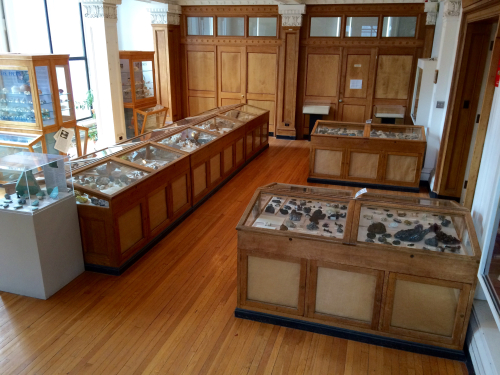
Four Pillars of the Redpath Museum: Mineralogy

MINERALOGY
What is the difference between a mineral and a rock? Well a mineral is a naturally occurring and specific chemical compound, whereas a rock is an aggregate of many different types of minerals.
HISTORY
The largest portion of the Redpath Museum’s historic collection is geological material, including rocks and minerals. Geology was one of the specialties of the Museum’s first director: Sir John William Dawson. It is therefore only fitting that Dawson would have a mineral named after him: Dawsonite.
Dawsonite was first collected by Dawson in 1862, when fragments containing the mineral were unearthed during an expansion to the McGill Arts Building. Initially, the mineral was thought to be unimportant and was disregarded. When it was re-examined by B.J. Harrington, it was discovered to be a unique mineral. The McGill campus lies on a large Dawsonite deposit and it is frequently unearthed during building projects, including the construction of the Leacock Building, and the Redpath Museum itself. A fragment of Dawsonite, collected in the 1860s, can be seen on the far right of the centre shelf.
ON DISPLAY
Minerals can come in a wide variety of shapes and colours, and can be found all over the world. The centre shelf, with the exception of the Dawsonite, contains minerals found from Mount Saint Hilaire. Notice how the two on the left have many different shapes and colours in them? This is because these two are aggregates of many different types of minerals. The black minerals on the first specimen are Aegirine, and the pink on the second is Serandite.
The shape and size of the mineral’s crystal also varies widely. The Natrolite specimen on the centre shelf next to the Dawsonite has hundreds of thin spikey crystals, while the quartz crystals on the bottom right shelf are larger, longer, and sleeker. These differences are due to differences in the chemical composition of these types of minerals. Looking at the quartz specimens on the bottom right shelf, you can see that the same mineral might also come in different colours. Often differences in colour arise due to differences in chemical composition or growth imperfections purple quartz is called ‘amethyst’, while the black is referred to as ‘smoky quartz.’ The bottom left shelf also contains an example of a mineral that can come in different colours: Vesuvianite. This mineral comes in both the purple and the green colours that you can see on this shelf.
The Redpath Museum has over 20,00 mineral specimens in their collection, most of which originate from Mont Saint Hilaire—a world renowned mineral site which has produced over 4000 different mineral species including 65 type species. Want to learn more about our mineralogy collection? Please visit the second floor of the museum! Outside of the Dawson Gallery we have a wide variety of minerals from all around the world, and inside the Dawson Gallery we have our local Quebec mineral collection.